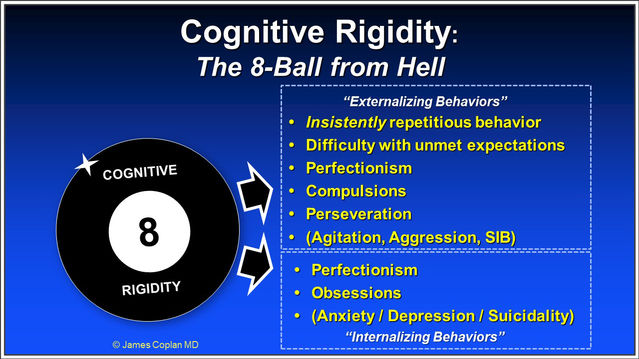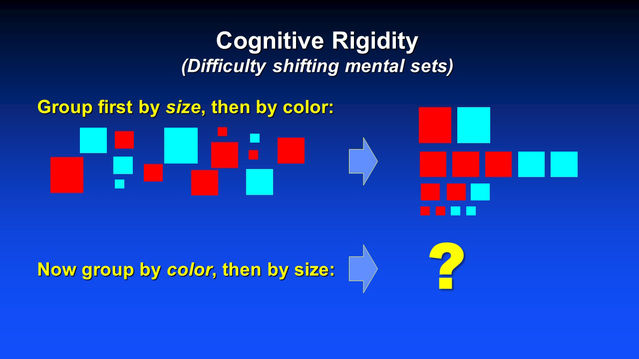Autism
Cognitive Rigidity: The 8-Ball from Hell
Cognitive rigidity is one element in a suite of challenging traits.
Posted August 1, 2016 Reviewed by Abigail Fagan

When I was a kid – eons before Pokemon and X-Box – my friends and I would amuse ourselves with a Magic 8-Ball. You’d ask the 8-Ball a question (“Will I pass the algebra quiz tomorrow?” “Does so-and-so like me?”), give the ball a shake, and then peer into a little window on the bottom for its reply. Sometimes it was definitive (e.g., “Signs point to yes”), but often ambiguous (“Are you sure you really want to know?”).
Despite the advent of electronic games, the 8-Ball has retained its popularity, and has spawned many imitations, including an astrology 8-ball, and “Dr. Freud’s Amazing Therapy Ball,” a tongue-in-cheek psychotherapy tool which features responses such as “MMM-hmmmm,” “Tell me more…,” and “How long have you felt this way?” For those who are hooked on electronics, there’s an online version, and an 8-ball app for your phone, although in my opinion, these are not nearly as much fun as the real thing.
What has all of this got to do with autism? I think of cognitive rigidity – one of the core features of ASD – as “The 8-Ball from Hell,” with behaviors and traits extending far beyond the core features of ASD, impacting virtually every aspect of the individual’s life. In this post, I will briefly summarize these behaviors and traits. I will elaborate on them in subsequent posts.
The technical definition of cognitive rigidity is “difficulty changing mental sets.” Simply put, this means switching from thinking about things one way to thinking about them a different way. (People who can do this easily are said to have "cognitive flexibility" — the opposite of cognitive rigidity.)
Let’s say I give you a pile of red and blue blocks of different sizes and ask you to sort them by "first by size, then by color." Then I repeat the task, with different colors or shapes. Each time, your task is to sort by size, then by color. By the way, this is a timed task, and you’ll earn extra points for speed, and at the end, you get to cash in your points for a prize. You’ve been doing this task for 10 or 15 minutes, and you’re getting pretty good at it; your times are coming down.
Then I throw you a curveball: With the next set of blocks, I say, “Sort these first by color, then by size,” the opposite of what you’ve been doing up to now. Making that kind of switch requires cognitive flexibility. The first few times, you may catch yourself involuntarily doing it the old way, in spite of yourself. And that's on a simple block-sorting task! Think of how much more powerful cognitive rigidity becomes for more complex, or deeply embedded tasks and behaviors.

Cognitive rigidity is all around us. How many times have you heard perfectly intelligent individuals resist something, offering as their only objection the protest “I’ve never done it that way before”? (Thus, the noted English economist John Maynard Keynes famously quipped "The difficulty lies, not in the new ideas, but in escaping from the old ones, which ramify, for those brought up as most of us have been, into every corner of our minds.") There is a certain comfort that comes from familiarity.
On the other hand, some people are so stuck in one way of doing things that they miss out on a lot — and any unexpected changes throw them for a loop. This trait is not unique to ASD, of course. We were talking in an earlier blog post about the Broad Autism Phenotype — people with autistic-like traits that fall short of ASD itself. Cognitive Rigidity is one of those traits!
If that were the whole story, it would be simple. But it’s not that simple. Cognitive Rigidity does not occur in isolation. Rather, Mother Nature “bundles” cognitive rigidity with a suite of other traits and behaviors. Find one of these traits or behaviors, and you’ll frequently find the rest of them lurking about — either within the individual or within other members of that individual’s family.
In the lead figure, I’ve divided these associated traits and behaviors into “Externalizing” and “Internalizing.” “Externalizing behaviors” are things that are visible on the outside; “internalizing behaviors” are things we carry around on the inside. (In that sense, “Internalizing behaviors” are more a state of mind rather than a behavior. But we are stuck with the term.)
In the upper box (“Externalizing Behaviors”) we find insistently repetitious behavior, difficulty with unmet expectations, perfectionism, compulsions, and perseveration. In parentheses, I’ve listed Agitation, Aggression, and Self-Injurious Behavior (“SIB”). I’ve put these in parentheses because they are not direct expressions of Cognitive Rigidity. Rather, they are the downstream consequences that arise if a person with Cognitive Rigidity is not able to fulfill his or her rigidly held expectations.
In the lower box, I’ve listed the “Internalizing Behaviors” that usually accompany cognitive rigidity. Notice that I’ve listed “Perfectionism” in both the upper and lower boxes. That’s not a mistake. Rather, it’s to emphasize that perfectionism qualifies as an externalizing behavior when we see its visible manifestations (relentless hand-washing in someone with OCD, for example), as well as an internalizing behavior (the overwhelming need to get things “just right”). Likewise, obsessions (recurrent, intrusive thoughts) are the silent, internal partner of compulsions (outwardly visible repetitive behaviors).
Finally, we come to the big killers (literally as well as metaphorically): Anxiety, Depression, and Suicidality. Like agitation, aggression and SIB, anxiety, depression and suicidality are not direct expressions of Cognitive Rigidity. Rather, they represent either associated neuropsychological traits (because of the way the brain is wired) or downstream consequences.
I’ll go into detail on all of this in follow-up posts. To learn more, check out my web page and book.




